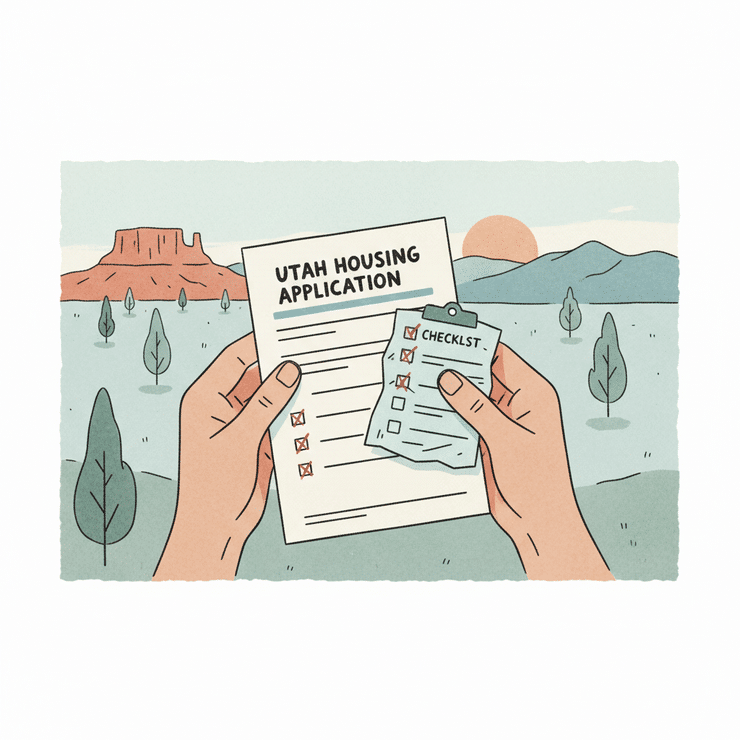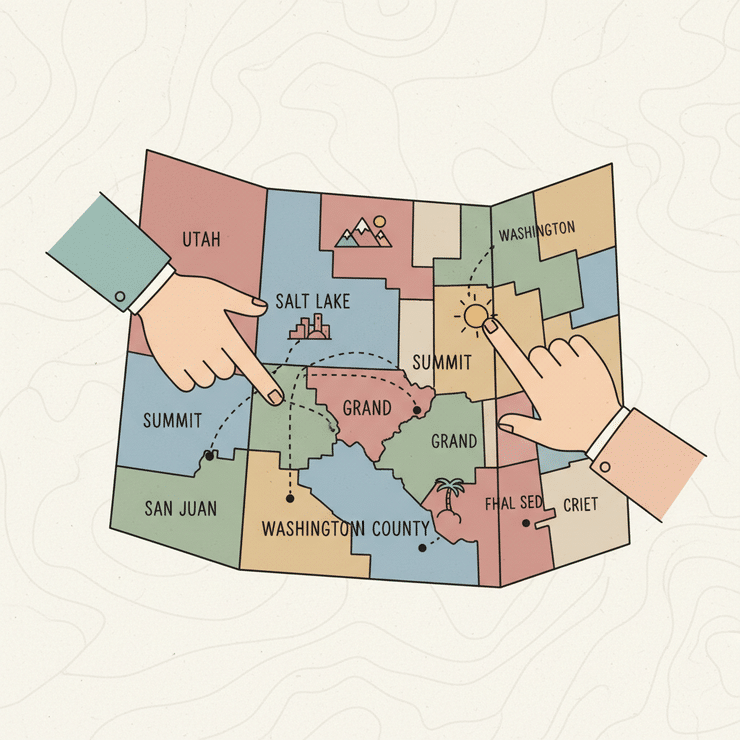Disclaimer: This guide is not government-affiliated. Information provided as-is without warranty of accuracy. Contact your local housing authority to verify current information. | Last Updated: September 25, 2025
Utah’s Section 8 system isn’t just slow—it’s a maze designed to make you give up, and I know because I almost did. If you want a real shot at housing in 2025, you need the hacks nobody puts on the government websites: which lists to stalk, which words unlock emergency preference, and how to outlast the paper-pushing gatekeepers. Don’t waste another minute—this is your playbook to beat a rigged game, and you need to start now.
Critical Legal Info for Utah
In Utah, landlords play by their own rules when it comes to Section 8 vouchers—no state law stops them from saying no. Cities and counties haven’t stepped in either, so voucher holders are left unprotected from source-of-income discrimination. If a landlord’s refusal is really about race, disability, or another federally protected trait, Fair Housing laws might apply. Document everything, keep your options open, and don’t give up—finding a willing landlord can be tough, but persistence and a solid paper trail work in your favor.
You’re Looking for Affordable Housing in Utah—Here’s Why It’s So Hard
Look, nobody ends up Googling “Section 8 Utah” at midnight for fun. You’re here because the rent just doubled, the landlord’s getting aggressive, or the bills keep stacking up and you’re one paycheck away from living in your car. Maybe you’ve already slept in it. This isn’t some sad story on the news—this is your life right now, and every second you waste waiting for things to get better is just another step closer to being completely out of options.

Here’s what actually happens: you hit all the official websites, fill out forms that go nowhere, and watch the “waitlist closed” messages pile up. You’re not crazy—the system is designed to wear you down. Most people give up before they get close. That’s by design: fewer applications, less work for the housing office. The truth nobody tells you? It’s not about who’s most “in need”—it’s about who refuses to quit the game, even when it’s rigged.
So let’s get real: you need the Utah-specific hacks, not generic advice. This is your on-the-ground playbook for 2025, not some sugarcoated pamphlet. I’m talking which waitlists to refresh every morning like it’s concert tickets, how to make the right kind of noise if you’re in crisis (yes, there are emergency loopholes—and they don’t advertise them), and all the behind-the-desk stuff housing staff say when the door’s closed. You want Section 8 in Utah? You need to know what they won’t tell you, and you need it yesterday. No shortcuts, no empty promises—just the moves that actually get you a shot at housing.
Yeah, it’s messed up, but here’s how to deal: keep reading, and don’t waste time hoping the system will get easier. It won’t. But you can get through it if you know where to hit it hardest.
Section 8 Is Available in Every Utah County—Here’s How to Use That
Don’t let anyone tell you there’s “nothing in your area.” Section 8 is in every damn county in Utah—zero exceptions. Read this out loud if you need to:

Salt Lake • Utah • Davis • Weber • Washington • Cache • Tooele • Iron • Box Elder • Summit • Uintah • Wasatch • Sanpete • Sevier • Carbon • Duchesne • San Juan • Millard • Morgan • Juab • Emery • Grand • Kane • Beaver • Garfield.
Every one. If you live in Utah, Section 8 is technically available where you are. But here’s what actually happens: the housing authorities aren’t just one tiny office per county. A lot of them cover multiple counties, and that is the trick nobody tells you. You might live in Morgan, but if Weber County Housing Authority has their list open, you can apply there—even if Morgan’s is closed. The boundaries are way fuzzier than they make it sound. Don’t get boxed in by your ZIP code.
Here’s how you play it: Don’t just wait for your own county to open. Get aggressive. Apply to every single open Section 8 waitlist within 100 miles of you. Seriously—Google “[your county] housing authority” and every neighboring county too. Lists open and close with almost no warning, sometimes for just a few days, and they don’t exactly blast it on the news. One list closes, another pops open next door. If you’re not checking weekly, you’re missing shots.
Let’s talk about the wait: it’s brutal. Some Utah cities run on a lottery system, and maybe you get a call in a year or two if you’re lucky. Other places? You’re staring at 3+ years, easy. And the messed up part? They can randomly change the order or close the list with zero notice. You think you’re next, then boom, it’s another year. Don’t let them act like it’s predictable—it’s not.
Insider move: Utah’s borders are just lines on a map. If you live anywhere near Idaho, Nevada, Colorado, or Wyoming, start searching for their Section 8 lists too. You don’t have to be a resident to apply in most cases, and sometimes those lists are way shorter. That’s a backdoor nobody mentions, but it can shave literal years off your wait if you’re willing to move.
Bottom line: Section 8 is everywhere in Utah, but the system is a maze built to confuse you. You gotta work every angle, every county, even every nearby state. That’s how you get a shot.
What Section 8 Housing Really Means in Utah

So here’s what actually happens: Section 8—yeah, it’s called the Housing Choice Voucher Program, but nobody calls it that—means the feds pick up a chunk of your rent. Not the whole thing. They pay your landlord directly, and you cover the rest. If you thought you’d just waltz into a free apartment, sorry, that’s not how it works.
Utah has its own flavor of Section 8 headaches. There’s this thing called the Landlord Incentive Program. Here’s what nobody tells you: some landlords hate dealing with vouchers (paperwork, inspections, the works). But this program sometimes throws them a bone—like a cash bonus—if they take you in. If you can sniff out who’s in on it, your odds get better. So don’t just look for “Section 8 accepted” in ads; ask straight up about landlord incentives. Sometimes the smaller, not-so-fancy complexes are more game.
What Utah Section 8 Applicants Are Facing in 2025
Ready for the ugly part? The average wait time for Section 8 in Utah right now is about 28 months. That’s more than two years. And no, it’s not speeding up. If anyone says otherwise, they’re straight-up lying. You get in line, and that line is crawling.
Back in 2023, about 36,000 people in Utah were living in subsidized housing. Most of the heads of household are women. Nearly a third? Someone in the unit has a disability. If you’re in either boat, you’re not alone—but you’re still waiting.
Out of roughly 20,000 subsidized units in the state, only about 11% are open at any given time. That’s just over 2,000 units floating around for everyone who’s desperate. So yeah, supply is a joke compared to demand. Don’t let anyone pretend there’s a secret stash of empty apartments waiting for you.
Section 8 Myths in Utah That Are Costing You Time
- Myth: You can only apply to your local county. Truth: Apply everywhere you can—every single county, every housing authority. There’s no rule saying you need to stick to where you live. The more lists you’re on, the less likely you’ll get left out in the cold.
- Myth: There’s a magic back door. Truth: Yeah, there are emergency preferences—like if you’re fleeing domestic violence or are literally homeless. But here’s the catch: even with a preference, you’re still in the same overcrowded line, just nudged up a bit. It’s not a golden ticket. You’ll still be waiting, just maybe not quite as long. Paperwork has to be perfect, and you’ll probably have to prove your crisis multiple times.
- Myth: You’ll get in fast if you have kids. Reality: Having kids or being disabled can help bump you up on a list, but don’t think you’ll get in tomorrow. These waitlists are savage—even the highest priority applicants can be stuck for months or years.
Bottom line: Section 8 in Utah isn’t impossible, but it’s a grind. If you’re feeling the walls closing in, knowing these realities is the only way to play the game smart. Get on every list you can, call and ask about landlord incentives, and don’t fall for the “fast track” fairy tale. Yeah, it’s messed up, but now you know how to move.
Step-by-Step Plan to Get Section 8 in Utah
Here’s what actually happens if you want a shot at Section 8 in Utah in 2025: you have to move fast and get ruthless with your organization—because the system will screw you if you let it.

Step 1: Get Every Housing Authority on Your Radar—Now Don’t sit around waiting for a perfect day. Google your county housing authority, and every neighboring county’s housing authority—even if you think you’d never live there. Use search terms like “Salt Lake County housing authority” and “Tooele County housing authority.” Anyone within 50 miles. Do it today. The truth nobody tells you: some counties randomly open their waitlists for a single afternoon, no warning, and if you’re not watching, you’re out for another year. Outdated websites? Yeah, that’s normal. If a site looks sketchy, Google “[your county] housing authority” and call anyway—don’t wait for them to update anything.
Step 2: Grab Every Document They Might Ask For Here’s what you need, no excuses: birth certificates, Social Security cards, last 3 pay stubs, bank statements, your current lease, and any medical/disability paperwork you might have. Don’t have them? Start chasing them down now—it takes weeks to replace some of this stuff, and nobody will give you extra time because “you’re waiting on Social Security.” Scan everything to PDF and keep it in a folder on your phone or email. If you show up with paper, half the time they act like you brought nothing at all. PDFs are king.
Step 3: Build Your Tracking Spreadsheet This isn’t optional. Create a spreadsheet with columns: Authority Name, List Status, Date Applied, Login Info, Next Check Date. Add every authority you contacted. This is your lifeline. Lose track of a list and you’ll never hear from them again. People lose YEARS because they forgot a login or missed a single update email. Organization literally saves you months—sometimes years.
Step 4: Calling Script—Do Not Overshare When you call, use exactly this: “Hi, I need to know if your Section 8 list is open and when the next opening might be.” That’s it. Don’t tell them your life story—nobody cares, and sometimes it actually works against you. Get the facts, write them down, hang up. The truth: staff are overworked and won’t remember you unless you annoy them, so keep it efficient.
Step 5: Surviving Online Portals When a waitlist opens online, the site will crash and the portal will freeze. Set alarms for the minute it opens. Have all your files prepped and labeled as PDFs. Be ready to hit refresh for hours if you have to. If you wait until after lunch, you’re done. They close the list the second the quota hits, and it’s not coming back for months, sometimes years.
Step 6: Follow Up Like a Pro (Every 30 Days—No Exceptions) Here’s the game: every 30 days, send a quick email or call—“Just checking my status.” Not 29 days (they’ll clock you as desperate), not 31 (they’ll forget you). 30 days is the sweet spot—they notice you’re paying attention, but you’re not a pain. Miss a check-in and you could get dropped—no warning, just gone.
Yeah, it’s messed up. But if you work the system like this, you actually have a shot. Don’t wait. Don’t trust them to remind you. Do it all yourself, and you might just beat the odds.
How to Find Section 8 Help in Utah That Actually Works
Here’s what actually works when you’re desperate for Section 8 in Utah—not the recycled advice you’ll get from some bored caseworker. Don’t waste time poking around dead-end websites. Start with this:

- Google these EXACT phrases:
- “[county] housing authority waiting list”
- “Utah Section 8 application”
- “affordable housing [zip code]”
Don’t try to get clever or use technical lingo. The system is too broken for that. These are the search terms the real applicants use, because they actually pull up the stuff you want: open waiting lists, applications, and whatever scraps of info the housing authority bothered to post. If you find a site that looks like it hasn’t been updated since 2015? Welcome to Utah housing. Ignore the clutter and just look for dates—if the waiting list says “OPEN” anywhere, jump on it. If not, set a calendar reminder to check again in a week.
- Facebook groups are gold. Search for:
- “[City] Housing Authority Updates”
- “Section 8 Utah”
- “[County] Affordable Housing”
Turn notifications ON—don’t just join and forget it. People in these groups post about list openings, sudden application drops, and loopholes before the official sites ever mention it. The truth nobody tells you: the best info always leaks here first, because people are watching the sites like hawks and racing you to the same spots.
- Not all nonprofits are created equal. Some Utah nonprofits actually help you get a place; others will just shuffle you through intake forms and then ghost you for months. Here’s the trick: when you see a group’s name popping up in Facebook comments or Google reviews (and people are actually saying they got housed), that’s the one to trust. If it’s crickets or just generic praise? Don’t waste your energy.
- Housing authority websites are a mess. Don’t get lost in the maze. Go straight to the “News” or “Announcements” tab—this is where they post about waiting list openings, which is all you care about. The rest is ancient history or just legal mumbo-jumbo. If there’s no announcement, there’s no list—move on.
- Legal fast tracks (and the only real way to jump the line):
- If you’re homeless, running from domestic violence, disabled, or at risk of being institutionalized, don’t just fill out the standard app. Ask (and use these words) about: “emergency preferences,” “disability accommodations,” and “family unification programs.” This is the only way anyone moves up faster than years-long waits. Yeah, it’s messed up, but that’s the system. If you qualify, say so upfront—don’t let them bury you in the regular pile.
Bottom line: Don’t let the maze slow you down—search smart, use social media for the real scoop, and if you have any legal preference, push it hard from the start. That’s how people actually get in.
What to Expect from Section 8 in Utah—The Good, Bad, and Ugly
Alright, here’s what actually happens when you go for Section 8 in Utah. Nobody at the office will say this out loud, but you need to know before you waste time or get blindsided.

The Good
If you’re one of the lucky ones who lands a voucher, your rent nosedives—like, hundreds off every month, sometimes saving you thousands a year. That’s real money back in your pocket, and you can finally stop panicking every first of the month. Utah landlords are getting new kickbacks (the Landlord Incentive Program is the big one), so more of them are slowly opening their doors to Section 8. Don’t expect magic overnight, but it’s actually getting a little less hopeless.
Here’s another thing: your voucher isn’t chained to one city. You can use it anywhere in Utah, and sometimes in the states next door if you need to run (it’s called “porting”). That’s huge if you want out of a bad situation or need to chase work. And get this—rural counties aren’t just tumbleweeds and nothing. Some of them have way shorter lists and less cutthroat competition. If you’re desperate, don’t sleep on the small towns.
The Bad
Now for the truth nobody tells you: the average wait is 28 months. That’s two whole years, plus a couple months. Seriously, picture two birthdays, two winters, two summers—still waiting. And those lists? They close all the time with no warning, then open again quietly, so if you miss it, you’re screwed for another year. Set yourself calendar reminders, check obsessively, do whatever it takes.
Think you’re golden once you get the voucher? Nah. Landlords don’t have to take Section 8, even with all the new incentives. You’ll call, you’ll email, and most property managers will straight up ghost you once you mention Section 8. Why? The paperwork’s a nightmare on their end too, and most don’t want to deal with it.
Speaking of paperwork—get ready for a mountain of it. Every form, every pay stub, every stupid signature. And their online portals? They crash constantly, especially right before deadlines. If you miss even one piece of paper, you’re bounced off the list, no warning, no mercy.
The Ugly
Here’s the part that makes people lose hope: some folks wait five years or more. That’s not a typo. Five. Years. There are zero guarantees—being desperate, homeless, sick, whatever—doesn’t mean you get in any faster.
Now, about those “emergency preferences”—yeah, they help, but they don’t mean you get to cut the whole line. You just move up a few spots, not straight to the top. If you think you’ll get housed next month because your situation is bad, that’s not how it works.
And the nastiest secret? Most housing authorities won’t tell you if you’re bumped down or dropped off the list. You’ll only find out when you call to check or when you never get a letter. No warning, no appeal. You have to chase them, not the other way around.
Yeah, it’s messed up, but now you know. That’s how you play the game and don’t get blindsided.
Take Action Today
Here’s what actually happens: if you sit around waiting for a housing authority to call you, you’ll be waiting until your phone fossilizes. This is a do-it-yourself system, and you’ve got to get loud and organized, fast. Start a spreadsheet right now—not later, right now. List every Utah housing authority you can find. Google ‘[your county] housing authority’ and ignore the sketchy third-party sites (they’re everywhere, half are outdated, just focus on anything ending in .gov or the official county sites). The truth nobody tells you: you can apply to more than one list. So do it. Every. Single. List. Even if the wait is years, your future self will thank you for getting that clock ticking.

Gather your documents—ID, Social Security card, proof of income, whatever paperwork they ask for. Don’t wait for the perfect stack, start with what you have and keep adding. If you’re missing something, still get that application in; you can usually update your file later. Housing authorities lose paperwork all the time, so keep digital copies of everything in a folder. Screenshot your submissions. Save every confirmation number. You’re building your own paper trail, because nobody else is going to do it for you.
Set a recurring reminder on your phone for every 30 days. No excuses. On that date, check every list you applied to. Call, email, or log in online (whatever method they use, and yeah, some sites look like they were built in 1998). When you call, use this exact line: “Hi, I’m checking the status of my Section 8 application, can you confirm I’m still active on the waitlist?” If they say they’ll call you back, don’t wait—call again. Persistence is not annoying. It’s survival.
Jump into Facebook groups and housing forums tonight. You’ll find people posting about list openings, paperwork shortcuts, and which offices are actually picking up the phone this week. This is where the real information lives—not on official sites. Search ‘Utah Section 8’ or ‘[your city] housing help’ and start lurking or asking questions. People drop gems in these groups that you’ll never hear from a caseworker.
Don’t Wait for a Perfect Moment
Here’s what nobody tells you: there’s never a “right” time to apply. Your life doesn’t have to be sorted—just get your name in the system. The sooner you do, the sooner your clock starts, and in this game, time is everything. Most people who actually get Section 8 didn’t wait for all their ducks in a row. They applied everywhere, kept pushing, and didn’t let themselves get frozen by how unfair or random it all feels. Yeah, it sucks. But you’re playing the only game in town.
Remember: You’re Not Alone
Thousands of people in Utah are stuck in this same impossible grind. It isn’t just you. The process is brutal. The only thing that works is staying organized and relentless. You’re already doing the hardest part—don’t let the broken system wear you down. Keep moving, keep checking, and never settle for “no” as the final answer. If you get a rejection letter, call and ask why. If your status disappears, demand a written explanation. People get housing by refusing to disappear. That’s the move. Stay loud, stay on their radar, and don’t stop until you’ve got those keys in your hand.